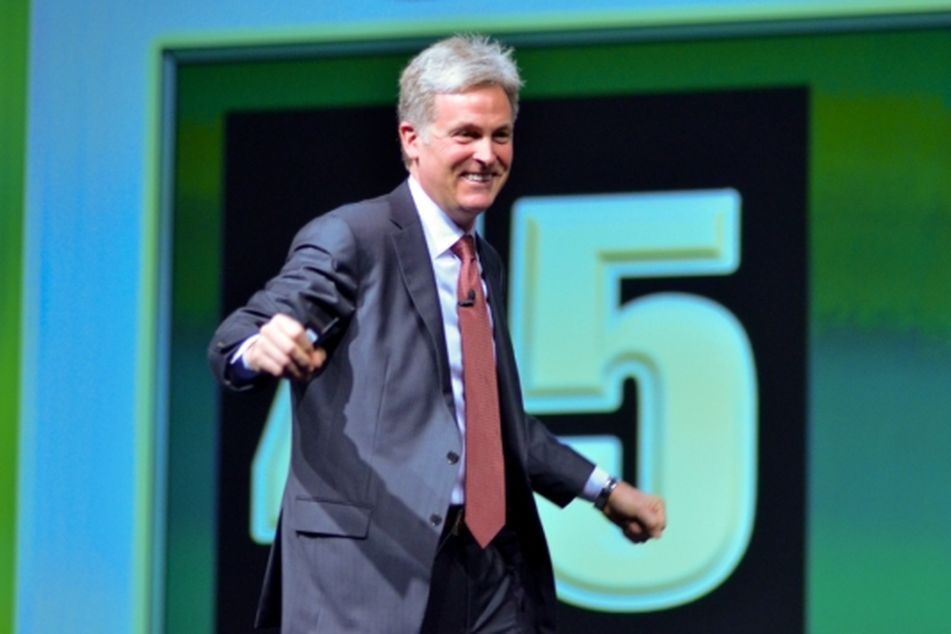A closer look inside TD’s executive shuffle
 Tom Bradley on stage at the 2012 TD Ameritrade Institutional Conference.
Tom Bradley on stage at the 2012 TD Ameritrade Institutional Conference.
Tom Bradley is stepping down as president of TD Ameritrade Institutional to become president of the brokerage's retail business. The big question: Is he being groomed to succeed TD boss Fred Tomczyk?
The announcement late Monday that Tom Bradley will step down as president of TD Ameritrade Institutional to become president of the retail business at TD Ameritrade Inc. caught some observers by surprise, as the company’s annual RIA conference concluded just last week in Orlando, Fla. without a word about the pending change.
He will be replaced by Tom Nally, head of institutional sales.
“We didn’t have this [succession plan] firmed up until over the weekend,” Mr. Bradley said in an interview yesterday.
Also not announced until this week was the departure of John Bunch, the former head of retail, resigned Jan. 31, the day before the conference started.
Mr. Bunch, who is leaving the firm at the end of this week, has been named the CEO at The Mutual Fund Store, the RIA founded by Adam Bold.
“It was probably better to wait over the weekend anyway” for the announcements, Mr. Bradley said. “There were so many things to talk about at the conference, it would have been a distraction.” (Watch InvestmentNews editor Jim Pavia’s interview with Mr. Bradley at the 2012 TD Ameritrade Institutional Conference last week.)
The change is a promotion for Mr. Bradley, 49, who has been involved in the RIA custody business since 2000 and has been seen as a rising star in the company.
A key question, of course, is whether he is being groomed to take over for Fred Tomczyk, 56, chief executive of TD Ameritrade Holding Corp.
“I’ll let Fred comment on that,” Mr. Bradley said. “But Fred probably has succession in mind.”
With the new job, “my focus now is on my new role,” Mr. Bradley said. “Retail is a significant part of the business, and I’m incredibly excited about it.”
Mr. Bradley, who joined Ameritrade Holding Corp. when it bought TD Waterhouse USA in 2006, has experience in the individual investor business.
“In my first 12 years in the business, I was in the pot in retail in one way or another,” he said.
Now it’s time for Mr. Nally to take over the institutional business, Mr. Bradley said.
“I hired Tom Nally … and have been grooming him for this job for a long time,” he said. “There’s no one better suited to take over the reins from me. He runs all aspects of it. We’ve worked very well together, to make sure we have a very strong bench. We’re ready.”
Mr. Nally has been with the company since 1994 and is a 12-year veteran of Mr. Bradley’s management team.
With his promotion, Mr. Nally also will join the company’s senior operating committee, a group of executives responsible for strategic direction.
“We’ve been doing an excellent job of executing on our strategy, and we’ll continue to push forward with the same passion,” he said.
That includes being a “strong advocate for the RIA community,” Mr. Nally added.
Under Mr. Bradley, the firm has been outspoken in supporting a fiduciary duty for advisers and keeping oversight with government regulators, rather than turn regulation over to the Financial Industry Regulatory Authority Inc.
He acknowledged his prominence in the industry, but insisted that “a year from now [Mr. Nally] will be as well-known.”
The company holds about $160 billion in custody for more than 4,000 advisers. RIAs account for 40% of the firm’s asset total and about 60% of its net new asset flows.
Mr. Bradley is credited with the firm’s aggressive efforts to market itself against two larger competitors — Schwab Advisor Services and Fidelity Institutional Wealth Services — as well as building a unique open-architecture technology platform by giving software developers access to its code.
Last year, Mr. Bradley was rewarded with a 35% pay increase, the most of any executive at the firm.
The management shuffle “speaks well of TD Ameritrade leadership,” said Steve Winks, an industry consultant.
Financial firms will need leaders who understand the advice model, he said.
Mr. Bradley “has been immersed in [the RIA business] — that’s his identity,’ Mr. Winks said.
Mr. Nally will remain in Fort Worth, Texas, where the Omaha, Neb.-based company has a presence. Mr. Bradley will continue to work out of the firm’s Jersey City, N.J., offices.
Mr. Bradley acknowledged his prominent role, but insisted that “a year from now [Mr. Nally] will be as well known.”
Mr. Bradley has indeed been something of a rising star at the firm.
RIAs account for 40% of the firm’s asset total, but about 60% of its net new asset flows.
Mr. Bradley is credited with the firm’s aggressive marketing efforts in competing its two larger custodians—Schwab Advisor Services and Fidelity Institutional Wealth Services—as well as building a unique open-architecture technology platform by giving software developers access to its code.
Last year, Mr. Bradley was rewarded with a 35% pay increase, the most of any executive at the firm.
The management shuffle “speaks well of TD Ameritrade leadership,” said Steve Winks, an industry consultant.
Financial firms will need leaders who understand the advice model, he said.
Mr. Bradley “has been immersed in [the RIA business]–that’s his identity,’ Mr. Winks said.
Mr. Nally will remain in Fort Worth, Texas, where the Omaha, Nebr.-based company has a presence. Mr. Bradley will continue to work out of the firm’s Jersey City, N.J. offices.
Learn more about reprints and licensing for this article.








